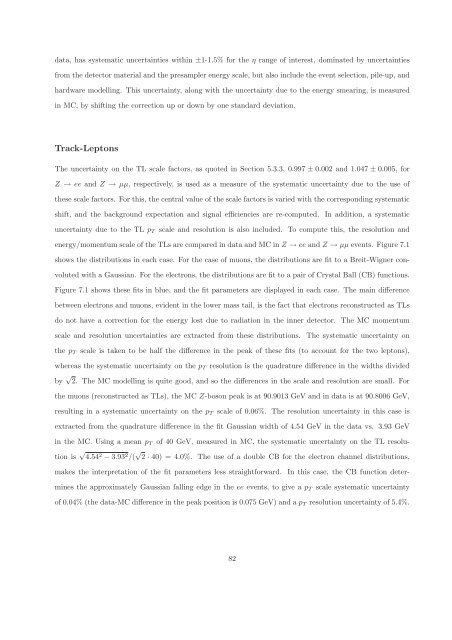CERN-THESIS-2012-153 26/07/2012 - CERN Document Server
CERN-THESIS-2012-153 26/07/2012 - CERN Document Server
CERN-THESIS-2012-153 26/07/2012 - CERN Document Server
You also want an ePaper? Increase the reach of your titles
YUMPU automatically turns print PDFs into web optimized ePapers that Google loves.
data, has systematic uncertainties within ±1-1.5% for the η range of interest, dominated by uncertainties<br />
from the detector material and the presampler energy scale, but also include the event selection, pile-up, and<br />
hardware modelling. This uncertainty, along with the uncertainty due to the energy smearing, is measured<br />
in MC, by shifting the correction up or down by one standard deviation.<br />
Track-Leptons<br />
The uncertainty on the TL scale factors, as quoted in Section 5.3.3, 0.997 ± 0.002 and 1.047 ± 0.005, for<br />
Z → ee and Z → µµ, respectively, is used as a measure of the systematic uncertainty due to the use of<br />
these scale factors. For this, the central value of the scale factors is varied with the corresponding systematic<br />
shift, and the background expectation and signal efficiencies are re-computed. In addition, a systematic<br />
uncertainty due to the TL pT scale and resolution is also included. To compute this, the resolution and<br />
energy/momentum scale of the TLs are compared in data and MC in Z → ee and Z → µµ events. Figure 7.1<br />
shows the distributions in each case. For the case of muons, the distributions are fit to a Breit-Wigner con-<br />
voluted with a Gaussian. For the electrons, the distributions are fit to a pair of Crystal Ball (CB) functions.<br />
Figure 7.1 shows these fits in blue, and the fit parameters are displayed in each case. The main difference<br />
between electrons and muons, evident in the lower mass tail, is the fact that electrons reconstructed as TLs<br />
do not have a correction for the energy lost due to radiation in the inner detector. The MC momentum<br />
scale and resolution uncertainties are extracted from these distributions. The systematic uncertainty on<br />
the pT scale is taken to be half the difference in the peak of these fits (to account for the two leptons),<br />
whereas the systematic uncertainty on the pT resolution is the quadrature difference in the widths divided<br />
by √ 2. The MC modelling is quite good, and so the differences in the scale and resolution are small. For<br />
the muons (reconstructed as TLs), the MC Z-boson peak is at 90.9013 GeV and in data is at 90.8006 GeV,<br />
resulting in a systematic uncertainty on the pT scale of 0.06%. The resolution uncertainty in this case is<br />
extracted from the quadrature difference in the fit Gaussian width of 4.54 GeV in the data vs. 3.93 GeV<br />
in the MC. Using a mean pT of 40 GeV, measured in MC, the systematic uncertainty on the TL resolu-<br />
tion is √ 4.54 2 − 3.93 2 /( √ 2 · 40) = 4.0%. The use of a double CB for the electron channel distributions,<br />
makes the interpretation of the fit parameters less straightforward. In this case, the CB function deter-<br />
mines the approximately Gaussian falling edge in the ee events, to give a pT scale systematic uncertainty<br />
of 0.04% (the data-MC difference in the peak position is 0.<strong>07</strong>5 GeV) and a pT resolution uncertainty of 5.4%.<br />
82















